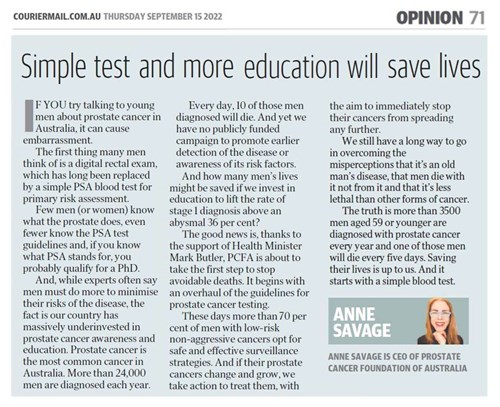The article below is an opinion piece published recently in the Australian media.
By Anne Savage
Prostate Cancer Foundation of Australia Chief Executive
If you try talking to young men about prostate cancer in Australia, it can cause embarrassment. The first thing many men think of is a Digital Rectal Exam, which has long been replaced by a simple PSA blood test for primary risk assessment.
But why does the threat of the DRE linger, derailing our efforts to promote earlier detection of the disease?
Perhaps because awareness of prostate cancer remains at an appallingly low level. Few men (or women) know what the prostate does, even fewer know the PSA test guidelines, and if you know what PSA stands for, you probably qualify for a PhD.
And while experts often say men themselves must do more to minimise their risks of the disease, the fact is our country has massively underinvested in prostate cancer awareness and education.
So who can really blame young men for occasionally poking fun, and for unknowingly growing older under its shadow?
At this point in the piece I'd ordinarily give you the figures on government spending for
prostate cancer awareness campaigns in Australia. Unfortunately, there are no campaigns to speak of. Take a moment to think about that.
Prostate cancer is the most common cancer in Australia. More than 24,000 men are diagnosed each year and prevalence of the disease is at an all-time high, with 240,000 men in our community alive today after being diagnosed.
Every day 10 of those men will die.
And yet we have no publicly funded campaign to promote earlier detection of the disease or awareness of its risk factors.
How many of us even know what the risk factors are?
And how many men's lives might be saved if we invest in education to lift the rate of
Stage 1 diagnosis above an abysmal 36 percent?
It's a loaded question, but not a trivial pursuit.
The good news is, thanks to the support of Health Minister Mark Butler, PCFA is about to take the first important step to stop the avoidable deaths of Australian men.
That step begins with an overhaul of the PSA guidelines for prostate cancer testing.
As many readers know, the existing guidelines are cursed by history, based on outdated evidence and limited by an earlier era of over-diagnosis which left many men angry about the damage caused by unnecessary treatment.
Those days are now behind us, and we have made marvellous advances in diagnosing, managing, and treating different forms of prostate cancer, introducing new medicines and ground-breaking technologies such as PSMA PET/CT scanning.
Just as importantly, these days more than 70 per cent of men with low-risk non- aggressive cancers opt for safe and effective surveillance strategies. And if their prostate cancers change and grow, we take action to treat them, with the aim to immediately stop their cancers from spreading any further.
But, the fact remains, we still have a long way to go in overcoming the misperceptions that it's an old man's disease, that men die with it not from it, and that it's less lethal than other forms of cancer.
The truth is more than 3,500 men aged 59 or younger are diagnosed with prostate cancer every year, and one of those men will die every five days.
We simply must do better. It is a tragic fact that younger men who develop the disease often have high-risk tumours, severely narrowing their survival prospects when the cancer is detected too late, once it has already broken outside the prostate.
And no Australian policy makers should ignore the evidence that 630,000 Australian men currently face at least double the risk of diagnosis due to their family history of the disease.
Saving their lives is up to us, and it starts with a simple blood test.
Learn more about PCFA's awareness campaign at www.thelongrun.org.au or call 1800 22 00 99 for support.







